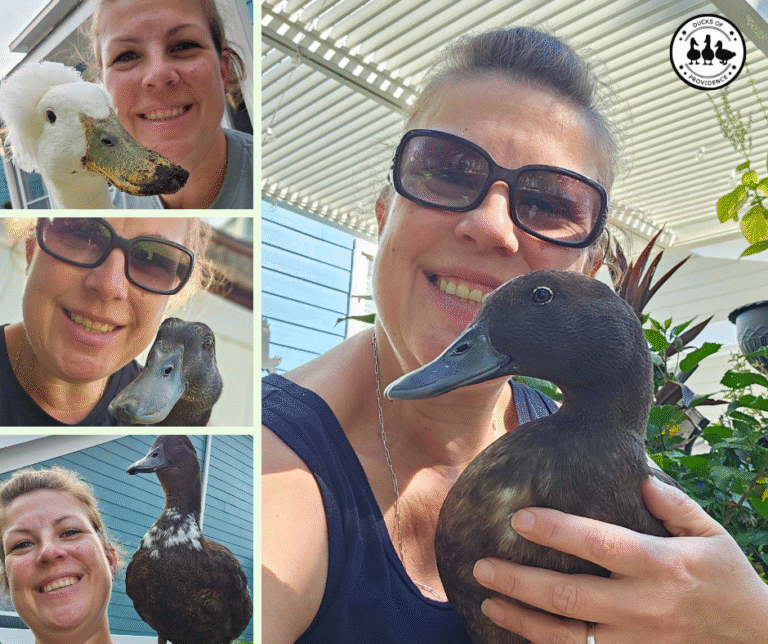Crissy O’s Clucky Chronicles: Jane Lily, the Pom-Pom Princess & Duck Diva!
This page is all about ducks and our great community. This is why we are especially excited to share a guest post from one of our friends: Chrissy O the host of the famous podcast Crissy O’s Clucky Chronicles
Crissy O here, back with another installment of Clucky Chronicles.
And today, we’re diving deep into the dazzling world of my most…shall we say… particular duck, Jane Lily.
Jane Lily, as many of you know, is a stunning white crested duck. Her snowy plumage is a sight to behold, but it’s her magnificent, fluffy pom-pom head that truly sets her apart. That glorious crest! It’s like she’s perpetually attending a royal tea party, complete with a feathered crown.
However, this regal headpiece comes with its own set of… challenges. Let’s just say, Jane Lily has fully embraced her inner diva.

The Pom-Pom Predicament:
Caring for a crested duck is a bit like caring for a celebrity with a demanding stylist. That
magnificent crest, while beautiful, requires special attention. Here’s a glimpse into the daily life of managing Jane Lily’s “do”:
- Cleanliness is Key: That pom-pom is a magnet for mud, bits of grass, and anything else Jane Lily decides to explore. Regular gentle cleaning is a must. I use a soft, damp cloth and carefully wipe away any debris. A little bird-safe shampoo is used when needed, followed by a thorough rinse.
- Water Woes: Crested ducks can have difficulty keeping their crests dry, especially when drinking or preening. Jane Lily has a tendency to get angry when she can’t fully
submerge herself because her pom acts like a floatation device. - Feather Flair: Sometimes, those crest feathers get a bit… unruly. A gentle comb-through with a wide-toothed comb helps keep things tidy. I’ve even considered tiny, bird-safe hair accessories, but I fear Jane Lily would simply deem them “beneath her.”
- The Diva Demands: Jane Lily knows she’s special. She expects the finest duck feed, the cleanest water, and the most luxurious nesting materials. If her demands aren’t met, she lets me know with a series of dramatic honks and indignant head shakes.

Jane Lily’s Royal Routine:
Despite her diva tendencies, Jane Lily is a joy to have in the flock. Here’s a peek into her daily routine:
- Morning Majesty: She begins her day with a thorough preening session, meticulously grooming her crest.
- Watering Hole Whimsy: After preening, she enjoys a dip in her shallow pool, though
I’m always on alert for potential pom-pom submersion incidents. - Grazing Glory: Jane Lily loves to graze on fresh greens and enjoys foraging for tasty bugs.
- Afternoon Antics: She spends her afternoons socializing with the other ducks, though she always maintains a certain air of superiority.
- Evening Elegance: As the sun sets, she retreats to her cozy nesting box, ready for a night of royal slumber.
Lessons Learned from a Pom-Pom Princess:
Jane Lily has taught me a valuable lesson: even the most demanding creatures deserve love and care. While her diva antics can be challenging, her beauty and personality make it all worthwhile.
Caring for a crested duck requires patience, attention to detail, and a good sense of humor. But the reward – a beautiful, unique, and utterly charming companion – is well worth the effort.
Be aware that some crested ducks can display some neurological disorders because that pom was created is a genetic mutation so let me explain here below:
Genetic Basis
The crest is caused by a genetic mutation. This mutation results in a gap in the duck’s skull, and the feathers of the crest grow from a mass of fatty tissue that protrudes through this opening.
The gene responsible for the crest is a dominant gene, but it also has a “lethal”
component. This means that if a duck inherits two copies of the crest gene (homozygous), it typically results in the embryo dying before hatching.
Therefore, crested ducks are usually heterozygous, meaning they have one copy of the crest gene and one normal gene.

Neurological Issues
Because the crest is linked to a skull defect, crested ducks can be prone to neurological problems. These can include:
- Seizures: The skull abnormality can sometimes lead to seizures.
- Other neurological problems: There are other neurological defecits that can occur.
- Increased risk of injury: The gap in the skull can make crested ducks more vulnerable to head injuries.
Breeding crested ducks requires careful consideration. Breeding two crested ducks significantly increases the risk of offspring with fatal skull abnormalities.
In essence, while the crest is a beautiful and unique feature, it’s essential to understand that it stems from a genetic abnormality that can have health implications. If done right and carefully you can have yourself a diva as healthy and demanding as Jane Lily! I wish ya’ll well and enjoy these Pom Crested Babies!
Until next time, keep those feathers fluffed and those beaks happy!
Crissy O. ✨
Want to continue reading related content?
➡️ Learn more about crested ducks and their genetic defect
➡️ Learn more about Neurological Disorders in Ducks
➡️ Get to know our crested Duck Emma



